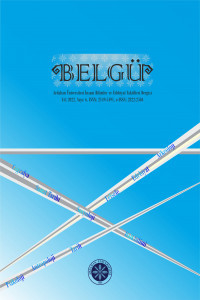KARMİK ADALET BİÇİMİNDE TOPLUMUN PARÇALANMIŞ AYNASI: AGATHA CHRISTIE'NİN AND THEN THERE WERE NONE ESERİ
Edebiyat, üretildiği toplumların sosyal yapılarını, kültürel normlarını ve güç dinamiklerini yansıtır ve yorumlar; bu da sosyoloji ve edebiyatı birçok farklı şekilde kesişen iki alan haline getirir. Edebiyat çalışmaları, günümüzün sosyal ve kültürel sorunlarına dair aydınlatıcı analizler sunmaktadır. Bununla birlikte, edebiyat ve toplum arasındaki karmaşık ve dinamik bağlantıları anlamak için bir çerçeve edebiyat sosyolojisi tarafından sağlanır. Edebi eserlerin sosyal ve kültürel gerçekliği hem nasıl yansıttığını hem de nasıl şekillendirdiğini fark ederek, etrafımızdaki dünyayı analiz etmek ve eleştirmek için edebiyatın nasıl kullanılabileceğini daha iyi kavrayabiliriz. Polisiye romanlar genellikle çok çeşitli sosyolojik konulara değinir ve yazıldıkları toplumların değerlerini, endişelerini ve kaygılarını yansıtan önemli bir türdür. Toplumsal meseleleri ve karmik adaleti en iyi yansıtan polisiye romanlardan biri, Agatha Christie'nin en popüler ve kalıcı romanlarından biri olan And Then There Were None'dır. Adalet, suçluluk, sınıfçılık, ırkçılık, önyargı, kefaret ve psikolojik travma gibi toplumu etkileyen konuları ele alarak toplumun nasıl yozlaştığını gözler önüne serer.
Anahtar Kelimeler:
Agatha Christie, And Then There Were None, Polisiye, Edebiyat sosyolojisi, Sosyal konular, Toplum
THE SHATTERED MIRROR OF SOCIETY IN THE FORM OF KARMIC JUSTICE: AGATHA CHRISTIE'S AND THEN THERE WERE NONE
Literature reflects and interprets the social structures, cultural norms, and power dynamics of the societies in which it is produced, making sociology and literature two fields that cross in many different ways. Studies of literature provide insightful analysis of contemporary social and cultural challenges. Nevertheless, the sociology of literature provides a framework for comprehending the intricate and dynamic connections between literature and society. We can better grasp how literary works can be utilized to analyze and critique the world around us by recognizing how they both reflect and shape social and cultural reality. Detective fiction often touches on a wide range of sociological issues and is an important genre that reflects the values, concerns, and anxieties of the societies in which they are written. One of the crime novels that best reflects social issues and karmic justice is And Then There Were None, one of Agatha Christie's most popular and enduring novels. It deals with issues that affect society such as justice, guilt, classism, racism, prejudice, redemption, and psychological trauma, revealing how society has degenerated.
Keywords:
Agatha Christie, And Then There Were None, Detective fiction, Literary sociology, Social issues, Society,
___
- Ahmadi, R. (2019). Sociology of literature. International Journal of Advanced Academic Studies, 3(1), 129-133.
- Alwaqaa, M. A. (2021). Sociology and Literature: An Interdisciplinary Approach. Journal of Liberal Arts and Humanities (JLAH), 34-38.
- Bangbang Puja Suastika, A. (2015). Agatha Christie’s Characterization Analysis through Sophıa in the Novel Crooked House. (MA Thesis). University of Jember, Indonesia.
- Blažková, E. (2006). The Portrait of English Society in Selected Novels of Agatha Christie. (BA Thesis). Masaryk University Brno, Czech Republic.
- Cechova, A. (2014). The Depiction of British Society in the Novels of Agatha Christie. (BA Thesis). Charles University, Czech Republic.
- Christie, A. (2003). And Then There Were None. HarperCollins.
- Characterization in And Then There Were None. (2018, August 29). PhD Essay. Retrieved April 20, 2023, from https://phdessay.com/characterization-in-and-then-there-were-none/
- Crenshaw, K. (1991). Mapping the Margins: Intersectionality, Identity Politics, and Violence Against Women of Color. Stanford Law Review, 43(6), 1241-1299.
- Dabaghian, J. (1975). Mirror of Man: Readings in Sociology and Literature. Little Brown.
- Dion, K. K., Berscheid, E., & Walster, E. (1972). What is beautiful is good. Journal of Personality and Social Psychology, 24(3), 285-290.
- English, J. F. (2010). "Everywhere and Nowhere: The Sociology of Literature After “the Sociology of Literature.” New Literary History, Project MUSE, doi:10.1353/nlh.2010.0005.
- Hall, S., & Jefferson, T. (2006). Resistance through Rituals: Youth Subcultures in Post-War Britain. London and New York: Routledge.
- Jalová, Z. (2007). Reflections of Society and Era in Hard-Boiled Detective Fiction. (MA Thesis). Masaryk University Brno, Czech Republic.
- Mannay, D. (2014) “And Then There Were None: Agatha Christie and Class.” Paper presented at the Cardiff Book Talk, Cardiff University, United Kingdom. Access address: https://www.researchgate.net/publication/270904804_And_then_there_were_none_Agatha_Christie_and_Class
- Mazella, R., & Feingold, A. (1994). The Effects of Physical Attractiveness, Race, Socioeconomic Status, and Gender of Defendants and Victims on Judgments of Mock Jurors: A Meta-Analysis. Journal of Applied Social Psychology, 24(15), 1315-1338. https://doi.org/10.1111/j.1559-1816.1994.tb01552.x
- Merrill, F. E. (1967). “The Sociology Of Literature.” Social Research, The New School, 34(4), 648–659.
- Quillen, W. T., & Hanrahan, M. (1993). A Short History of the Delaware Court of Chancery- 1792-1992. Delaware Journal of Cooperate Law, 18(3).
- Rouvinen, N. (2016). Constructing Masculinity in Agatha Christie's Novel And Then There Were None. (MA Thesis). University of Eastern Finland, Finland.
- Sistiadinita, S. (2021). “A Man in the Court: Explorıng the Theme of Justice in And Then There Were None.” Journal Ilmiah Spectral. 7. 051-062. 10.47255/spectral.v7i1.69.
- Swingewood, A., & Laurenson, D. T. (1975). The Sociology of Literature. New York: Schocken Books.
- Themes in "And Then There Were None". (2021, April 1). StudyMoose. Retrieved April 20, 2023, from http://studymoose.com/themes-in-and-then-there-were-none-essay
- Tihula, M. (2021). Gender and Sociocultural Changes in Agatha Christie’s Partners in Crime and Cat Among The Pigeons, (MA Thesis). University of Eastern Finland, Finland.
- Watt, I. (1957). The Rise of the Novel: Studies in Defoe Richardson and Fielding. Chatto & Windus.
- ISSN: 2149-5491
- Yayın Aralığı: Yılda 2 Sayı
- Başlangıç: 2015
- Yayıncı: Ardahan Üniversitesi
Sayıdaki Diğer Makaleler
HZ. ALİ’NİN İBADET ESASLARINA YÖNELİK FIKHÎ GÖRÜŞLERİ VE İÇTİHATLARI
BİRİNCİ DÜNYA SAVAŞI’NDA OSMANLI IRAK’INA DAİR BİR RAPOR: SORUNLAR, TARAFLAR VE TANIKLAR
TÜRKİYE’DE MÜZİK VE İLETİŞİM KONULARINDA YAZILMIŞ LİSANSÜSTÜ TEZLERİN BİBLİYOMETRİK PROFİLİ
ÖĞRENME KAYIPLARIYLA AİLENİN EĞİTİM DÜZEYİ VE EKONOMİK OLANAKLARI ARASINDAKİ İLİŞKİ
